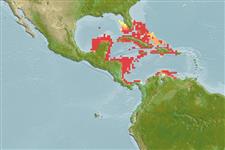Issue
The species in the genera Spratelloides Bleeker, 1851 and Jenkinsia Jordan & Evermann, 1896 should most probably be assigned to a separated family from Clupeidae and Dussumieriidae (Lavoué, pers. comm., July 2013). See a preliminary analysis in Lavoué et al. (2013: Ref. 93878).
Environment: milieu / climate zone / depth range / distribution range
Ecology
Marine; reef-associated; depth range 0 - 50 m (Ref. 188). Tropical; 28°N - 9°N, 93°W - 67°W (Ref. 188)
Western Central Atlantic: Gulf of Campeche; Bahamas, northwestern coast of Caribbean.
Size / Weight / Age
Maturity: Lm ? range ? - ? cm
Max length : 5.5 cm SL male/unsexed; (Ref. 188)
Dorsal
spines
(total): 0;
Anal
spines: 0. No teeth on pre-maxillae, 1 supra-maxilla; W-shaped pelvic scute; isthmus with distinct blunt `shoulders' anteriorly; vertebrae 38 (one fish); silver lateral band not fading away anteriorly. Lower gill raker counts correlated with geographical area: 24 to 28 for J. majua majua (Gulf of Mexico) and 21 to 24 for J. majua woodsi (Bahamas, northwestern Caribbean) (Whitehead, 1963).
Usually an inshore schooling species, feeding on zooplankton.
Life cycle and mating behavior
Maturity | Reproduction | Spawning | Eggs | Fecundity | Larvae
Whitehead, P.J.P., 1985. FAO Species Catalogue. Vol. 7. Clupeoid fishes of the world (suborder Clupeoidei). An annotated and illustrated catalogue of the herrings, sardines, pilchards, sprats, shads, anchovies and wolf-herrings. FAO Fish. Synop. 125(7/1):1-303. Rome: FAO. (Ref. 188)
IUCN Red List Status (Ref. 130435)
Threat to humans
Harmless
Human uses
Fisheries: subsistence fisheries
More information
ReferencesAquacultureAquaculture profileStrainsGeneticsElectrophoresesHeritabilityDiseasesProcessingNutrientsMass conversion
Tools
Special reports
Download XML
Internet sources
Estimates based on models
Preferred temperature (Ref.
123201): 25.2 - 28, mean 27.2 °C (based on 140 cells).
Phylogenetic diversity index (Ref.
82804): PD
50 = 0.5625 [Uniqueness, from 0.5 = low to 2.0 = high].
Bayesian length-weight: a=0.00389 (0.00180 - 0.00842), b=3.12 (2.94 - 3.30), in cm total length, based on all LWR estimates for this body shape (Ref.
93245).
Trophic level (Ref.
69278): 3.4 ±0.45 se; based on food items.
Resilience (Ref.
120179): High, minimum population doubling time less than 15 months (Preliminary K or Fecundity.).
Fishing Vulnerability (Ref.
59153): Low vulnerability (10 of 100).
